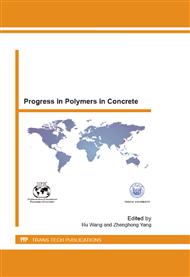p.311
p.316
p.322
p.329
p.335
p.341
p.347
p.354
p.359
Influences of Superplasticizer on the Interaction between Latex Particles and Cement Grains
Abstract:
In order to have a better understand on the interaction among superplasticizer, latex and cement grains in the fresh cement paste, the zeta potential and the adsorption of polymer on the cement were investigated in this study. The zeta potential was measured by using the ZetaProbe instrument, and the adsorption rate of latex was analyzed by sedimentation test. The zeta potential results show that the zeta potential of pure cement paste is positive and increasing slightly along the first 30mins; the latex particles can be adsorbed by cement grains, comparing with SAE latex, the adsorption of PAE latex is lower, and PAE latex has a smaller influence on the hydration of cement paste; the presence of superplasticizer can affect the adsorption of polymer particles on the cement; the sedimentation test results show that the presence of PC and NF can reduce the adsorption of latex particles, when the dosage of PC is more than 0.3%, the adsorption rate of latex particles is reduced significantly; when the dosage of NF is 1%, the adsorption rate of latexes is reduced less than that in the case of PC.
Info:
Periodical:
Pages:
335-340
Citation:
Online since:
April 2013
Authors:
Price:
Сopyright:
© 2013 Trans Tech Publications Ltd. All Rights Reserved
Share:
Citation:


